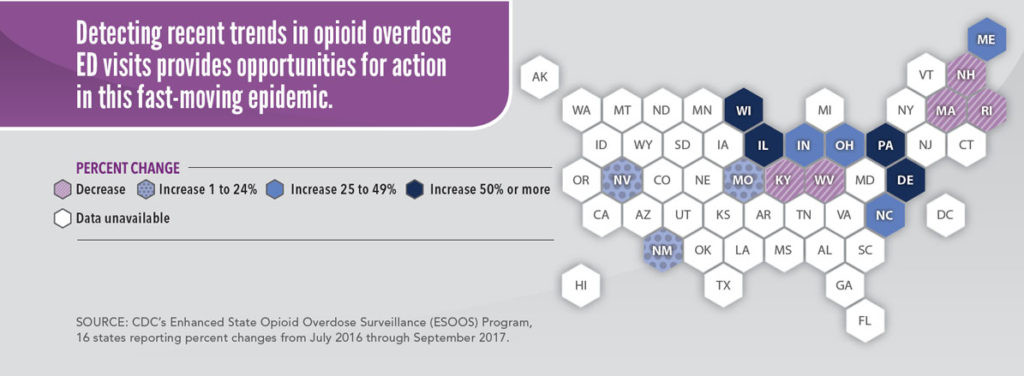From the CDC.
MMWR, March 9, 2018/67(9);279-285
Vital Signs: Trends in Emergency Department Visits for Suspected Opioid Overdoses – United States, July 2016-September2017
Data from emergency departments (EDs) show that the U.S. opioid overdose epidemic continues to worsen, according to the latest Vital Signs report by the Centers for Disease Control and Prevention (CDC).
The report examines the timeliest data available to CDC on ED visits for opioid overdoses across multiple states. Overall, ED visits (reported by 52 jurisdictions in 45 states) for suspected opioid overdoses increased 30 percent in the U.S., from July 2016 through September 2017. Opioid overdoses increased for men and women, all age groups, and all regions, but varied by state, with rural/urban differences. The findings highlight the need for enhanced prevention and treatment efforts in EDs and for greater access to evidence-based opioid use disorder treatments, including medication-assisted treatment and harm reduction services.
“Long before we receive data from death certificates, emergency department data can point to alarming increases in opioid overdoses,” said CDC Acting Director Anne Schuchat, M.D. “This fast-moving epidemic affects both men and women, and people of every age. It does not respect state or county lines and is still increasing in every region in the United States.”
ED data allow faster tracking of regional and state trends
Data from 16 states in CDC’s Enhanced State Opioid Overdose Surveillance (ESOOS) Program were analyzed, showing quarterly trends by state and rural/urban differences from July 2016 through September 2017. Overall, ED visits for suspected opioid overdoses increased 35 percent in these 16 states hit hard by the epidemic. The data show:
- Eight states from three U.S. regions reporting substantial increases—25 percent or greater—in the rate of opioid overdose ED visits.
- Significant increases in all states reporting in the Midwest, including Wisconsin (109 percent), Illinois (66 percent), Indiana (35 percent), Ohio (28 percent), and Missouri (21 percent).
- Considerable variation among states in the Northeast and Southeast; some states reported substantial increases and others modest decreases:
- In the Northeast, large increases were seen in Delaware (105 percent), Pennsylvania (81 percent), and Maine (34 percent), but other states, like Massachusetts, New Hampshire, and Rhode Island showed nonsignificant decreases (<10 percent).
- In the Southeast, North Carolina reported an increase (31 percent), while Kentucky reported a statistically significant decrease (15 percent).
- Continued rises in cities and towns of all types. Highest rate increases (54 percent) were in large central metropolitan areas (a population of 1 million or more and covering a principal city).
The sharp increases and variation across states and counties indicate the need for better coordination to address overdose outbreaks spreading across county and state borders. Closer coordination between public health and public safety agencies can support identification of changes in supply and use of illicit opioids, further allowing communities to take appropriate action to reduce opioid overdoses.
To read the entire MMWR, click here.
